How to Clean a Toilet Bowl Without Scrubbing
People have made it a culture and normal to clean the toilet by scrubbing it with a brush or some other abrasive cleaning tools. While scrubbing is easy, quick and cheap, it may not be the best method, especially when not done correctly. There are several alternatives to scrubbing.
You can clean the toilet bowl without scrubbing by using natural cleaners such as vinegar and baking soda, or automatic cleaners including tablets, gels and cartridges. Installing water softeners can also help in preventing buildup of stains and dirt. Read on for details and ideas.
Use of Automatic Toilet Cleaners
These cleaners keep grime from building up. Look for an automatic or continuous cleaner that fits inside your toilet tank. These devices release cleansing and disinfecting solutions into your toilet every time you flush so that you don’t have to scrub your toilet bowl nearly as often.
Automatic toilet cleaners come in a variety of forms. For example, some of them are gel packets that clip into the side of the toilet bowl, or capsules/tablets, while others are refillable cartridges that attach to the inside of the tank.
Use Cleaning Tablets/Capsules
These tablets release cleaners with every flush. Toilet cleaning tablets slowly release bleach or other cleaning chemicals into your toilet water, preventing the build-up of grime, bacteria, and foul odours. This is an easy way to cut back on scrubbing.
Method
Drop the cleaning tablet into the bowl and replace it as often as recommended on the package.
Flush the toilet. Every time you flush it, the cleaning tablets will clean the bowl.
Although most instructions on these tablets recommend placing them in the toilet tank, placing them directly in the bowl prevents chemical wear and stress on the tank’s hardware.
These tablets dissolve over time, but cheaper ones may break apart and cause your toilet drain to slow or block briefly. Choose trusted brands over generic ones to avoid flushing issues.
Some of the best and most reviewed capsules include:
Clorox Automatic Toilet Bowl Cleaner Tablets
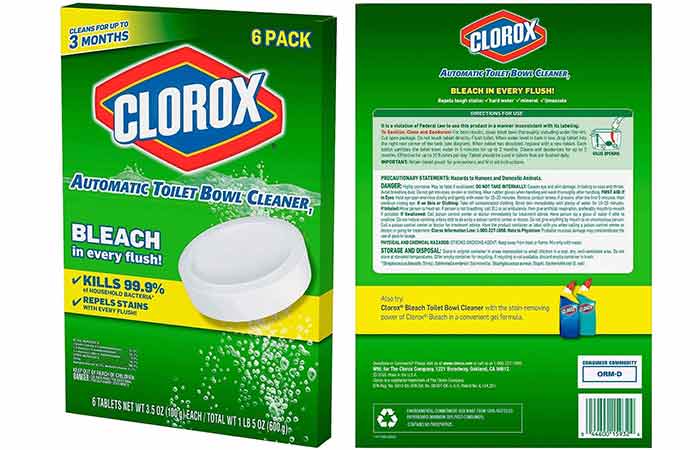
These are affordable bleach-based tablets that are good at disinfecting and whitening your bowl. You simply drop these tablets into the toilet’s tank then with each flush, they continuously clean, prevent stubborn stains, and deodorize.
Iron OUT Automatic Toilet Bowl Cleaner
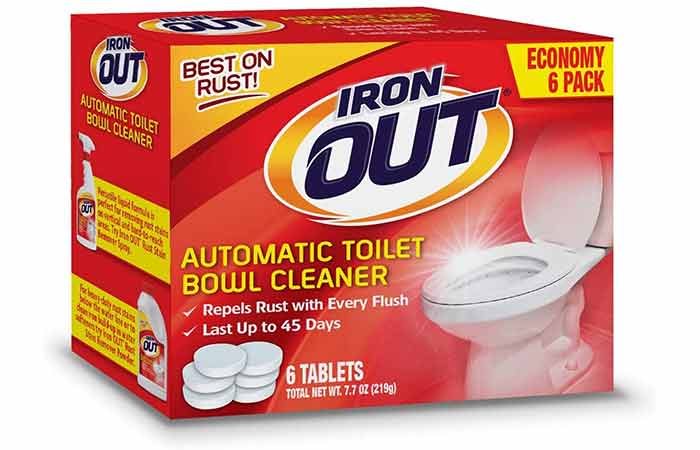
The Iron out tablets are good at removing rust, mold, and hard water stains. They are quite cheap. According to the manufacturer, these tablets won’t damage parts of your toilet or the septic system.
Clean Toilet Cleaning Gel
This is another simple but brilliant solution for busy people who don’t want to spend their time scrubbing to clean their toilets.
The gel covers your entire toilet bowl with an odor-eliminating film that helps keep odors from coming back. When you flush your toilet, the stamp releases the fragrance to help eliminate odors when you have company over or when you’re going through a tough time with gross bathroom odors.
Method
- Gently squeeze the cleaning gel of your choice on the toilet bowl.
- Let it stand for twenty to thirty minutes.
- Flush the toilet.
Follow the instructions on the package to install your toilet bowl cleaner and find out how frequently to replace or refill it. One of the top products of this kind is the Lysol Automatic Toilet Bowl Cleaner
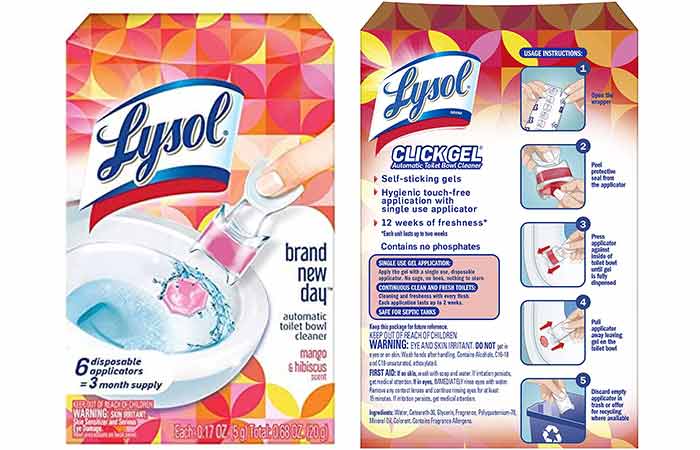
Lysol’s bleach-free gel automatic cleaner dispenses continuous refreshing action for up to a month. According to the manufacturer, it kills 99.9 germs and viruses
Cartridge Toilet Cleaning Systems
When it comes to automatic toilet cleaning systems, Fluidmaster’s Flush ‘n Sparkle is one of the most popular. This is an environmentally friendly cartridge that injects the cleaning solution directly into the overflow tube. It is easy to install and can last up to 3 months.
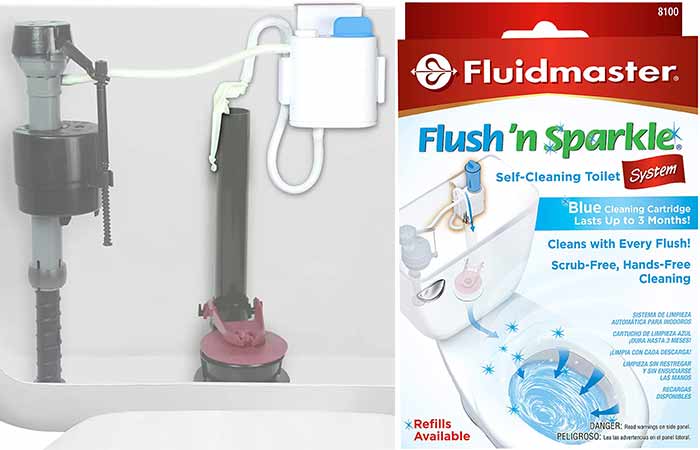
Use Natural Cleaners
For those who are sensitive to harsh chemicals or simply want an environmentally friendly cleaning option, a DIY natural toilet cleanser is the way to go.
Vinegar dissolves mineral deposits. It’s also a mild disinfectant, so it might destroy some microorganisms in your toilet bowl that cause odor. You can use vinegar on its own, mix it with warm water or baking soda. Citric acid is also another natural ingredient that you can combine with baking soda.
Note.
Using Vinegar alone
Follow the steps below to get rid of mineral deposits or hard water stains.
- Fill a container with distilled white vinegar.
- Dip a piece of toilet paper in the vinegar and lay it on top of the stained area.
- Repeat this process to cover any other discolored spots.
- Let the vinegar-soaked toilet paper sit in place for about four hours, then remove it from the stained areas with your gloved hands.
- Use the paper to gently wipe any remaining discoloration away.
Even though vinegar is a mild acid, it can cause skin irritation. Keep your hands, skin and eye protected by wearing gloves and goggles.
White Vinegar and Warm Water
If your toilet bowl appears stained or discolored, then it can easily be cleaned by using a little white vinegar and warm water.
Method
- To start, pour a cupful of warm water into the toilet bowl and then add one cup of white vinegar.
- Allow this mixture to sit for about five minutes.
- The next step involves pouring another cup of cold water into the toilet bowl to rinse away all the loosened dirt and grime from the surface.
Vinegar and Baking Soda
Hard water stains can be removed with this combination. Baking soda is abrasive and acts as a natural water softener, so it can remove a variety of stains. It also won’t damage the surface of your toilet bowl because it’s not as harsh as some other cleaners.
Baking soda draws dirt as well, so when you flush it away, your toilet will be spotless. Vinegar cuts through grease and soap scum and leaves a clean smell behind. It’s also great for getting rid of lime stains and mineral deposits.
Method
- Pour about 1 cup (0.24 liters) of white vinegar into your toilet and swish it around with a toilet brush, making sure to coat any stained areas.
- After about a minute, sprinkle baking soda liberally on any stains, then pour on another one cup of vinegar.
- Let the mixture sit for 30 minutes
- To flush to rinse away any remaining grime. This fizzy combo can also break up clogs in your toilet drain.
- If there are still any stains in the bowl, wipe them away with a rag or sponge.
Points to note!
Baking soda is an excellent way to improve the health of your septic tank on its own. Baking soda does not damage the healthy bacteria in your septic tank, unlike bleach and ammonia cleansers.
To maintain a good pH balance and prevent clogs and backups, pour one cup or twenty-two grams of baking soda into your toilet bowl and flush it once a week.
DIY Cleaning Bombers -Citric Acid & Baking Soda
These gentle cleansers may reduce the need for scrubbing. To make grime-busting toilet bombs, follow the steps below:
- Combine a quarter cup of citric acid, a half cup of baking soda and two teaspoons of liquid dish soap in a bowl.
- Fill a few small bath bomb molds with the mixture and let them set for twenty-four hours.
- Drop a bomb into your toilet bowl and let it dissolve to loosen stains and dirt.
- Let it sit for several minutes before flushing the toilet.
Some cleaning DIYers recommend adding a few drops of your favorite essential oil for a boost of fresh scent.
This is a good option for removing mild, light stains. If you still see any stains, toss in another bomb or wipe the stains away with a rag or brush.
Use Bleach
Bleach disinfects while also removing stains. To clean your toilet, most cleaning experts recommend using bleach-based products. If your toilet isn’t either badly filthy, you might be able to get away with minimal scrubbing or none.
Bleach works by releasing oxygen molecules through an oxidation process. Bleach releases oxygen molecules, which destroy chromophores’ chemical connections. Chromophores are chemical substances that cause color.
The chromophore molecules that have changed either reflect no color or a color that is not visible in the visible spectrum. Our eyes see this lack of color as white.
Method
Pour a bucket of water into your toilet bowl. This will cause it to flush without triggering the tank to refill the bowl.
Then, coat the entire bowl with a bleach-based cleaner.
Let it sit for at least two hours, then flush your toilet to rinse the bleach away.
If you’re not crazy about the idea of using harsh chlorine-based bleach (which contains sodium hypochlorite) in your toilet, seek a gentler alternative, such as oxygen bleach which contains hydrogen peroxide.
To avoid creating toxic fumes, never mix bleach with other household cleansers!
Hydrogen Peroxide
Hydrogen peroxide is a safe and effective germ fighter. Hydrogen peroxide is a chemical compound with molecules that contain two hydrogen atoms bonded with two oxygen atoms. It oxidizes compounds that are common in organic life, which disinfects surfaces.
It dissolves proteins by breaking them apart and releasing water and oxygen-free radicals. To clean your toilet with hydrogen peroxide, follow the steps below:
- Pour a half cup of hydrogen peroxide into the bowl
- Let it stand for thirty minutes
- Flush to rinse the bowl.
Use of Coke
Carbonation in the soda breaks down stains. Here’s how it works: The carbonic acid in Coke reacts with calcium carbonate, the main component of limestone. This reaction releases harmless bubbles of carbon dioxide which cause the limestone to foam up and, along with any dirt or oil, can be wiped away
Method
- Pour a bottle of Coke or a similar cola drink into your toilet bowl. Pour the soda in around the edges of the bowl to cover as much of the inner surface as possible.
- Let it sit in the toilet overnight, then flush it the next morning.
You can also clean the bowl using Coke by following the following steps:
- Pour coke into a spray bottle and spritz it directly on hard-to-reach areas.
- Leave it overnight,
- Flush the bowl the next morning.
Take note that Coke will dissolve some stubborn stains, but it won’t actually disinfect your toilet. For a deeper clean, follow up with a disinfectant spray or gel to kill lingering bacteria.
Use Muriatic Acid
This removes rust or lime stains on your toilet bowl. This powerful acid removes limescale. However, it can be dangerous, so use it as a last resort and follow the directions on the package carefully.
The process
- Empty the bowl by pouring a bucket of water into the bowl or shutting off the water supply to the toilet, then flushing.
- Mix 1 part muriatic acid with 5 parts water, then fill the toilet bowl with the solution.
- Close the toilet lid and let the acid sit for two to three hours.
- Follow the instructions on the package in how to remove the acid from the bowl, since muriatic acid can damage your plumbing if you flush it. Some may advise you to scoop it out of the toilet with an acid-safe container or neutralize it with baking soda.
Note that when using muriatic acid, always wear protective equipment, such as acid-proof rubber gloves, safety goggles, a respirator mask, and thick clothing that completely covers your skin.
Keep the bathroom well ventilated, and don’t let anyone use the bathroom until you’ve removed the acid.
More Tips to keep Toilet Bowl Clean without A Brush
You can install a water softener to prevent hard water stains in your bowl and tank.
If your water is particularly mineral-rich, this is a suitable alternative. If you cannot get rid of the mineral stains in your toilet with white vinegar or other acidic cleaners, you could consider getting a water softener or conditioner.
Look for a local installation of water softeners service. In your toilet bowl, a good water softener will prevent limescale, rust stains, and mineral deposits from forming.
If you use well water, which is often high in stain-causing metals and minerals, you may be a suitable candidate for a water softener.
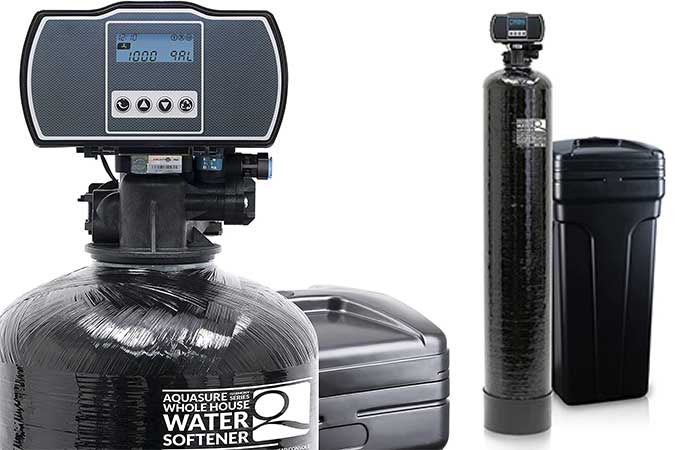
One of the best-selling softeners is the Aquasure Harmony Series Whole House Water Softener with High Efficiency Digital Metered Control Head (64,000 Grains)
Further Reading